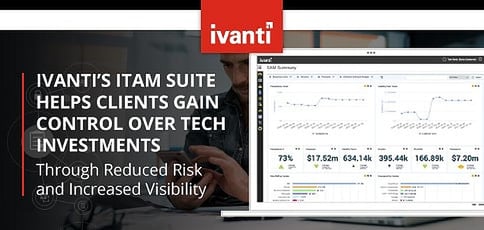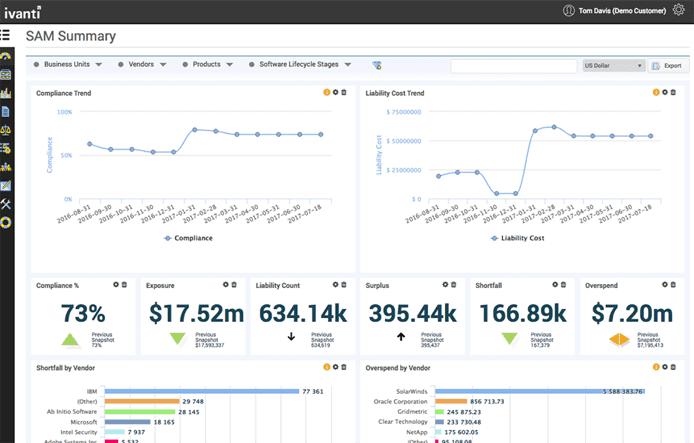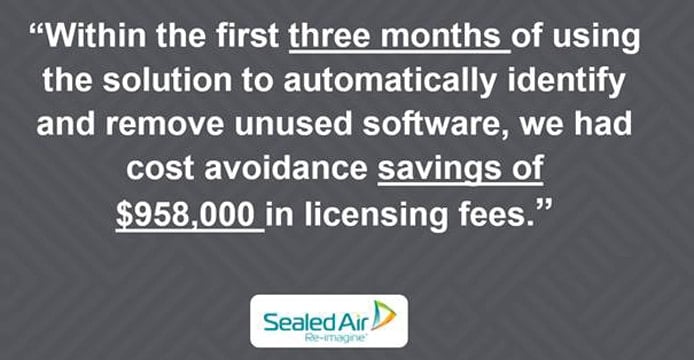
TL; DR: With more than three decades of experience in the tech sector, Ivanti operates with a mission to help customers clear the fog around their IT infrastructure — equipping them with increased visibility into assets and how well they’re performing. Ultimately, the company’s hardware and software asset management programs enable businesses to save money while reducing financial and reputational risk. We recently caught up with Phil Merson, Director of Ivanti’s Information Technology Asset Management (ITAM) Product Group, who shared how the company’s proactive and unified approach to ITAM helps organizations make the most of their investments.
These days, most offices depend on stashes of hardware and software to power their business needs, making strong IT asset management essential. Without proper visibility into IT assets, things can go downhill quickly — a lesson many businesses have learned the hard way.
Symptoms of an unhealthy information technology asset management (ITAM) strategy include swollen budgets, mismanaged hardware and software, and increased non-compliance. In extreme cases, a lack of asset management leads to problems so severe that immediate care is needed. For those businesses, Ivanti, a leader in asset management, offers one heck of a painkiller.
“We have customers who have to do something urgently that is very tactical around a trigger such as a software audit,” said Phil Merson, Director of Ivanti’s ITAM Product Group. “They’ll say, ‘I have a letter from a software vendor that tells me I have to do something within X weeks.’”

Ivanti’s Phil Merson told us how the company is giving businesses greater visibility into their IT infrastructure.
In these cases, the Ivanti team enters crisis mode, quickly outfitting the business with a suite of asset management products tailored around its pain points.
But the beauty of Ivanti’s ITAM solutions is they can also be used proactively — as vitamins, if you will. When administered this way, Ivanti’s solutions become part of a company’s long-term IT asset management strategy.
“This is far better than the tactical approach because you’re actually planning it rather than being in a reactive state,” Phil said.
Whether they’re healing wounds or taking a preventative care approach — Phil told us it’s a 50/50 split — Ivanti’s customers have the tools they need to optimize their software licenses, manage hardware lifecycles, and employ comprehensive IT asset strategies. The company’s unified IT management software solutions provide a complete picture of clients’ IT estates, enabling them to avoid overspending, improve efficiency, and meet compliance requirements. Overall, that’s not a hard pill to swallow.
A Proactive Approach to Mitigating Financial and Reputational Risk
The financial risks of mismanaged hardware and software are undeniably high, and murky license terms often require careful review. Just consider the 2017 SAP UK Ltd v Diageo Great Britain Ltd dispute, in which SAP sought approximately $66.4 million in additional licensing fees from alcoholic beverage producer Diageo, citing indirect usage violations.
“It became an open fight against the two organizations in which Diageo lost,” Phil said.
In this legal environment, organizations simply can’t afford software management mistakes — and that’s why risk reduction is high on Ivanti’s agenda.
“Governance, risk, and compliance are always part of our build-out for our product line,” Phil said. “We want to make sure our customers tick the box for those types of requirements, especially now that it’s all about making sure the customers have a full handle on all of their assets.”

Ivanti’s platform empowers businesses to reclaim unused software and ensure assets are running at peak performance.
Again, Phil pointed to the value of a proactive approach. If an organization isn’t properly tracking its assets, Phil told us it will almost certainly go into reactive mode.
“If you’re in a progressive and proactive position where you know your assets and you’re seeing information feeding through about those assets — whether it be hard or software — you actually know when things potentially could go wrong,” he said.
Take, for example, a product’s end-of-life (EOL) policy.
“If we know that a piece of software on a device has gone past its support date, that it’s EOL from a software vendor perspective, we can anticipate that there’s potentially going to be an issue when you upgrade to a new operating system,” Phil said.
Armed with this information, a business can simply patch products before an upgrade, avoiding any setbacks. As Phil noted, it’s a proactive mindset that makes sure the problem is fixed before it actually occurs.
Optimize Your Software License Position in the Office and Datacenter
Forget death and taxes. When it comes to the certainties of life, the folks at Ivanti are focused on a third: license audits.
“Let’s face it, virtually all customers nowadays have had at least one audit from a software vendor, whether in the SMB or enterprise sector,” Phil said.
Ivanti’s two software asset management solutions, License Optimizer for Clients and License Optimizer for Servers, help clients discover and track assets, monitor purchases, and convert license data into an accurate position.
“We can make sure the customer is in a position where they can go to the software vendor and say, ‘Look, we’ve got a full handle on all of our license positions. We know exactly how many users are using the product and how many licenses we have purchased and are allowed to use,’” Phil said.

Businesses are turning to Ivanti to ensure IT assets are working to improve bottom lines, and they’re reaping the rewards.
The two software solutions are available in formats designed for use in the office and on servers. The latter, Phil said, is more complicated when you factor in virtualization and clustering.
“To establish that full license position sounds simple, but it actually incorporates a large number of algorithms and licensing metrics,” he said.
Overall, the tools provide clients a clear view of their software licenses, enabling them to ensure compliance and, as an added bonus, reduce overspending.
“Through proper management, a customer can reduce their license costs,” Phil said.
Hardware Lifecycle Management That Saves Cost and Improves Security
In addition to software solutions, Ivanti’s hardware asset management solution administers the life of IT devices, such as servers, desktops, laptops, and printers, from purchase through disposal.
“It’s that full visibility of who’s got it, where it is, and how it’s being used, including total cost of ownership and return on investments in that lifecycle — it’s very robust reporting,” Phil said.
The product, currently available for on-prem use, to be joined shortly by a cloud option, as well, provides a plethora of benefits, including lowered maintenance costs, reduced system downtime, decreased hardware budgets, the ability to prevent data breaches through proper disposal, and the potential to save or make money through disposal.
“If [clients] can manage all their assets — from servers to client desktops and laptops, they can actually get rewards on their investments,” Phil said.
Harness the Power of a Unified IT and Asset Management Strategy
Ultimately, software and hardware asset management go hand-in-hand, as many software applications require specific hardware to run efficiently.
“In effect, they’re inextricably linked; you can’t get away from one or the other,” Phil said. “This forces our product lines closer and closer together so that they can actually be seen as a cross-sell, or a cross-implementation of the product sets within our organization.”
It’s the logic behind Ivanti’s emphasis on “unified IT,” as well as its ITAM Suite, a combination of the company’s hardware and software management products. The suite allows users to capture a full picture of inventory, software license management, and lifecycle management systems through an infographic-style Asset Manager Workspace dashboard.
“Our goal is to make sure that all of our customers are empowered to manage their hardware and software assets,” Phil said.
Most recently, the company has been preparing for the implementation of the May 25, 2018, General Data Protection Regulation (GDPR) intended to strengthen and unify data protection within the EU.
“With ITAM specifically, our product sets are actually very attuned to GDPR,” Phil said. “Where we hold information about a business set of assets, we’re keeping that on behalf of the business, so the business would have actually already engaged with the users around GDPR on what information is being held in those databases. We’re in a very good position.”
HostingAdvice.com is a free online resource that offers valuable content and comparison services to users. To keep this resource 100% free, we receive compensation from many of the offers listed on the site. Along with key review factors, this compensation may impact how and where products appear across the site (including, for example, the order in which they appear). HostingAdvice.com does not include the entire universe of available offers. Editorial opinions expressed on the site are strictly our own and are not provided, endorsed, or approved by advertisers.
Our site is committed to publishing independent, accurate content guided by strict editorial guidelines. Before articles and reviews are published on our site, they undergo a thorough review process performed by a team of independent editors and subject-matter experts to ensure the content’s accuracy, timeliness, and impartiality. Our editorial team is separate and independent of our site’s advertisers, and the opinions they express on our site are their own. To read more about our team members and their editorial backgrounds, please visit our site’s About page.

